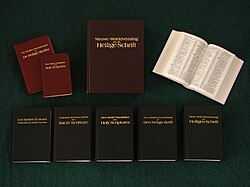
Back Bagong Kinaban na Traduksiyon kan Banal na Kasuratan BCL Святое Пісанне — Пераклад новага свету Byelorussian New World Translation of the Holy Scriptures Catalan Překlad nového světa Czech Bibelen - Ny Verden-Oversættelsen Danish Neue-Welt-Übersetzung der Heiligen Schrift German Η Αγία Γραφή-Μετάφραση Νέου Κόσμου Greek New World Translation of the Holy Scriptures English Traduko de la Nova Mondo de la Sanktaj Skriboj Esperanto Traducción del Nuevo Mundo de las Santas Escrituras Spanish
| New World Translation | |
|---|---|

| |
| Buong pangalan: | New World Translation of the Holy Scriptures |
| Daglat: | NWT |
| Wika: | 185 languages |
| Paglalathala ng BT: | 1950 |
| Paglalathala ng Buong Bibliya: | 1961 |
| Batayan ng teksto: | OT: Biblia Hebraica. NT: Westcott & Hort. |
| Uri ng salinwika: | Formal Equivalence with occasional ventures into Dynamic equivalence[1][2] |
| Katayuan ng karapatan sa kopya: | Copyright 1961, 1981, 1984, 2013 Watch Tower Bible and Tract Society of Pennsylvania |
| Mga kopyang nalimbag: | 227 million |
In the beginning God created the heavens and the earth. Now the earth proved to be formless and waste and there was darkness upon the surface of the watery deep; and God's active force was moving to and fro over the surface of the waters. And God proceeded to say: "Let light come to be." Then there came to be light. Henesis 1:1 sa ibang mga salinwika | |
For God loved the world so much that he gave his only-begotten Son, in order that everyone exercising faith in him might not be destroyed but have everlasting life. Juan 3:16 sa ibang mga salinwika | |
| Bahagi ng isang serye tungkol sa |
| Mga Saksi ni Jehova |
|---|
| Balangkas |
| Organizational structure |
| Kasaysayan |
| Demograpika |
| Panitikan |
| Mga programang pagtuturo |
|
|
| People |
| Mga pangulo ng Watch Tower |
| Mga impluwensiya sa pagkakabuo |
|
|
| Mga kilalang dating miyembro |
|
|
| Opposition |
|
|
Ang Bagong Sanlibutang Salin ng Banal na Kasulatan[3] o New World Translation of the Holy Scriptures o NWT ay isang salin ng Bibliya na inilimbag ng Watch Tower Bible and Tract Society noong 1961 at ipinamamahagi ng Mga Saksi ni Jehova.
Noong 2000 inilabas ng Mga Saksi ni Jehova ang salin ng Bibliya sa Pilipinas sa tatlong pangunahing wika: Tagalog, Cebuano at Iloko. Ang mga Saksi ay gumagamit na ngayon ng 941 na mga wika(mayroon ding Braille at Sign Language) sa buong daigdig kasama na ang Pilipinas sa pitong pangunahing wika: Bicol, Cebuano, Hiligaynon (o "longgo,") Iloko, Pangasinan, Samar-Leyte (o "Waray") at Tagalog.
- ↑ Jason D. Beduhn, Truth in Translation - Accuracy and Bias in English Translations of the New Testament
- ↑ All Scripture Is Inspired by God and Beneficial1990 pg. 326 pars. 32-33 Study Number 7—The Bible in Modern Times: New World Translation A Literal Translation, 1990
- ↑ http://www.jw.org/tl/publikasyon/bibliya/